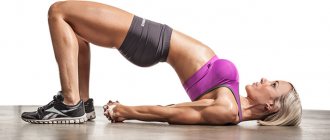Content
- 1 Cardio workouts 1.1 Best cardio workouts for home
- 3.1 How can you speed up your metabolism?
- 4.1 COMPLEX A
- 5.1 Daily Workouts FREE
Cardio training[edit | edit code]
Interval Cardio Training
Cardio training
(abbreviated
cardio
) is a synonym for aerobic training. Cardio training is recommended:
- to maintain tone and improve health 1-3 times a week
- for weight loss and drying 3-5 times a week
- when gaining muscle mass 1-2 times a week
Cardio training goals:
- Strengthening the cardiovascular system. This is especially true for people who are just starting to train.
- Increased stamina
- Fat Burning
Don't forget to monitor your heart rate. The optimal frequency can be calculated using Body Expert. The optimal duration is 30-60 minutes. Shorter workouts are ineffective.
The best cardio workouts for home[edit | edit code]
cardio training as a basis
by BJ Gaddour.
Also use video lessons that can be easily found on VKontakte, Yandex video, mail video. We recommend the following video workouts that you can do at home:
BeachBody - Insanity
- 00: Dig Deeper
- 01: Fit Test
- 02: Plyometric Cardio Circuit
- 03: Cardio Power Resistance
- 04: Cardio Recovery
- 05: Pure Cardio
- 06: Cardio Abs
- 07: Core Cardio Balance
- 08: Max Interval Circuit
- 09: Max Interval Plyo
- 10: Max Cardio Conditioning & Abs
- 11: Max Recovery
- 12: Insane Abs
- 13: Max Interval Sports Training
- 14: Upper Body Weight Training
Killer Buns and Thighs
- Jillian Michaels - Killer Buns and Thighs. Level 1
- Jillian Michaels - Killer Buns and Thighs. Level 2
- Jillian Michaels - Killer Buns and Thighs. Level 3
Cardio training for the abs
- Six Week Pack (Level 1)
- Six Week Pack (Level 2)
Special forces training
Dative program for home and street, developed by a professional intelligence instructor.
How to speed up fat burning?
The whole problem of excess weight in the body is slow metabolism. Accordingly, if it is accelerated, fat burning will occur faster and more efficiently. In addition, even at rest, your average calorie expenditure will increase.
One of the most effective methods for boosting your metabolism is high-intensity interval training to burn fat. (
We advise you to learn how to start losing weight correctly to achieve quick results.
It would seem that increasing the intensity of a fat-burning workout, say running at speeds, leads to an increase in heart rate (HR) or pulse rate. At the same time, the fat burning zone is considered to be the interval of 60-70% of your maximum, which is calculated as 220 - your age in years. Exceeding this zone means a decrease in energy consumption from fats and an increase from carbohydrates. And the higher the pulse value, the less fat is burned during exercise.
At the same time, the increased intensity of the training accelerates your metabolism and the total daily calorie expenditure increases significantly, which leads to impressive results.
Since our body, and in particular the cardiovascular system, is not adapted to long-term, high-intensity exercise, the best solution would be to carry it out at certain intervals.
High-intensity interval training or low-intensity cardio training?[edit | edit code]
Why does cardio continue to be a hot topic in all fat loss discussions?
After all, as we all know, cardio alone cannot radically change body composition. New times have come and many studies have proven that in fact, strength training is more effective in the fight against fat deposits. Despite this, people prefer to sit on an exercise bike for hours with a magazine and revel in reading gossip about the life of bohemians. You're free to do what you want, but wouldn't it be better to try to get the most out of your training? In this article we will compare the two most popular types of cardio - HIIT and NICT. By reading this article to the end, you will get an idea of which type of cardio is best for you.
So, what do the mysterious acronyms HIIT and NIPT mean?
HIIT
is High Intensity Interval Training, consisting of alternating sprints and low- or moderate-intensity cardio.
For example: 30 seconds of sprinting followed by 4 minutes of walking until your heart rate returns to normal, then repeat as many times as necessary. NICT
is Low Intensity Cardio at a Constant Pace. This could be walking on a treadmill or pedaling an exercise bike at a pace that allows you to carry on a conversation with someone. Now that you have an idea about these types of cardio, let's get down to the details.
Why do you need to test your lactate threshold (LT) and anaerobic threshold (AT)?
LA and AP are excellent indicators of cardio efficiency. Our muscles burn glucose (blood sugar) in two ways: aerobic (with the participation of oxygen) and anaerobic (without the participation of oxygen). For example, NICT is considered aerobic work, while resistance training or HIIT is considered anaerobic work. LA and AP are great tests for cardio as they help determine at what load ATP (adenosine triphosphate) is produced. ATP provides a quick burst of energy to working muscles (for example, every time you curl a barbell, ATP is produced). HIIT, unlike NICT, increases the body's ability to tolerate physical activity. High-intensity training forces you to work beyond your LP and AP, which results in a faster metabolism, which leads to more intense fat burning over time. But during NICT you do not achieve your LP and AP.
How can you speed up your metabolism?[edit | edit code]
Read the main article:
Metabolism
- It is necessary to increase muscle mass and muscle oxidative capacity. Your muscle tissue contains energy-producing structures called mitochondria, which are where ATP is produced and fat is burned. The more mitochondria you have, the more active they are, the more oxidative capacity your muscles will have and the faster you will lose excess fat. HIIT improves mitochondrial performance and increases their number.
Research shows that with high-intensity training, you lose more fat because the oxidative capacity of muscle fibers increases. With NICT, you only burn calories while you exercise. Low-intensity cardio does not speed up your metabolism. Moreover, your body gets used to this load and you have to increase the duration of your cardio sessions to continue burning fat. Most people don't realize that for best results, you need to go beyond comfort and try to expend as much energy as possible. And if you feel pain during HIIT, it means your body is working in an uncomfortable mode and you are doing everything right!
- Our body quickly gets used to everything. We have all seen people who spend hours doing NICT. In theory, they should lose extra pounds, but this does not happen because their metabolism has adapted to low-intensity training. Their body only burns calories during exercise, and their metabolism does not accelerate.
By doing NICT consistently, you will get results that you could get with diet alone. For example, you burn 200 calories in 30 minutes of NICT. But you could miss out on those 200 calories by reducing the amount of carbohydrates or fat in your diet. Plus, you could use HIIT to speed up your metabolism.
- A study conducted by Dr. Wilson from the University of Tampa, Florida, shows that when you start doing NICT, you will initially lose weight, but the effects are fairly short-lived. In the first week of the experiment, the subjects lost about a kilogram, and after that a plateau occurred. This happened because their metabolism had completely adapted to the new regime of physical activity. In addition, NICT combined with a low-calorie diet may lead to muscle loss.
During a low-calorie diet, NICT is a more catabotic (muscle-breaking) activity, as opposed to HIIT, which is gentler on muscle tissue. The reason is that your metabolism adapts to NICT and you have to increase the duration of your cardio sessions. And reducing the caloric content of the diet often occurs by reducing the consumption of carbohydrates. Glycogen stores in your muscles are depleted, and your body needs energy. And where do you think the body will get energy from? From proteins! And your muscles are made of proteins!
- The same study found that NICT caused greater muscle loss than HIIT. The thing is, your muscles work differently during these workouts. It's just like weight training! HIIT is another way to stimulate muscles. As an illustrative example, compare the physique of a sprinter and a marathon runner.
It's hard to argue with this research. Unfortunately, NICT is not able to stimulate muscle fibers in the same way.
- In another study, conducted by Dr. Naito from Juntendo University in Japan, it was found that the body of experimental rats intensively produces satellite cells, not due to the duration of endurance training, but due to its intensity.
Most of you will say: “Well, those are rats.” However, it should be said that the rat’s body, like a human’s, synthesizes protein and has reactions to amino acids and their metabolism similar to our body. For those who are hearing about satellite cells for the first time. These cells create new muscle fibers in our body, which in turn leads to muscle growth. So, research has shown that when rats were subjected to HIIT, muscle fiber growth was stimulated. No such reaction was observed during NICT. This proves that cardio is all about intensity, not duration.
Now many of you are probably sure that HIIT is more suitable for developing muscles and burning fat. However, it should be noted that NICT is not completely useless. It makes sense to combine these types of cardio for the following reasons:
- You can't do HIIT 5-6 days a week because it will end up being bad for your weight training and muscle growth.
- Many people have contraindications (orthopedic, cardiological and even psychological) to HIIT and can only do it with NICT
- If used incorrectly, HIIT can cause injury
Therefore, saying that HIIT is more effective for changing body composition is as false as saying that 6 reps per set is better than 20. HIIT and NICT each have their own unique benefits. Both types of cardio are worthy of inclusion in your training program. In general, we leave this to your discretion. Choose the type of cardio that you like best. A HIIT session is shorter, more effective at getting rid of excess fat, speeds up metabolism and helps maintain muscle mass. But not all people can do HIIT. NICT is safer, but it will take you twice as long to burn the same amount of calories. In addition, NICT does not affect metabolism in any way.
We didn't intend to force you to choose any one type of cardio, even if you thought so. It’s just that times have changed and science has discovered a lot of new things about HIIT. Ultimately, it's up to you to decide which type of cardio is best for you. We hope that after reading this article, it will be easier for you to decide. If you are still in doubt... Just start training!
Description
Are you excited and can't wait to hop on the treadmill for another 45-minute walk?
Don't think.
Bored, tired - the first words that come to mind. But you've already read all the articles urging you to hit the treadmill, bike or elliptical machine for many hours every week to finally lose the last drop of fat.
There must be a better way. A more effective way to make your muscles more defined. And he is.
You might already be familiar with the term HIIT (or high-intensity interval training). What it is?
This is a type of cardiovascular exercise characterized by high levels of intensity over short periods of time with short periods of rest in between. Each of these intervals is repeated a certain number of times in each workout. They are designed for a moderate-to-short duration of the entire workout and cause excess post-exercise oxygen consumption (EPOC), forcing the body to burn calories long after the end of exercise.
This way you get the advantage:
Here are 5 unique, different 20-minute HIIT fat-burning workout programs for fast fat loss. You'll crank up the intensity and finish in record time!
Conditioning training with kettlebell
Only one weight is used here. Therefore, you will have to balance your body, which will force the stabilizer muscles, core and other sleeping muscles to work under extreme loads. This, in turn, will challenge the cardiovascular system while training your core muscles.
Perform 4-5 circles with a minute break for 10-15 repetitions.
| Exercise | Repetitions |
| One-Arm Chest Raise | 10-15 |
| Swing in front of you with both hands | 10-15 |
| Kettlebell Front Squats | 10-15 |
| One arm overhead press | 10-15 |
| Reverse lunges | 10-15 |
| Crunches on the floor | 10-15 |
So you might be interested in: the best exercises with kettlebells.
Outing into nature
Nothing beats training in nature. Fresh air, no queues for exercise equipment, the ability to do cardio anywhere. Let's add sprints to interval aerobic training. Let's say no to the treadmill and its boring friends. This will allow us to get the benefit of real running exercises that don't require pressing a button.
Perform one of the following sprint interval workouts, alternating as desired:
Unconventional incinerator
High-intensity workouts for fat loss should not degrade into banal running or cycling. Some unconventional ways to get thin are becoming the norm. Pulling/pushing sleds, kettlebell exercises, and plyometric work are not only effective, but they can also get you moving, taking the boredom that comes with traditional forms of cardio out of the equation.
Perform 3-4 rounds of the following workout, resting 2 minutes in between.
| Exercise | Repetitions |
| Pushing the sled | 10 meters |
| Swing the kettlebell in front of you | 10-15 |
| Sled pull | 10 meters |
| Burpee | 10-15 |
| Jumping on a plyometric platform | 10-15 |
| Push ups | 10-15 |
| Hanging leg raises | 10-15 |
Fat melter at home
If the equipment does not allow or you do not want to go to the gym, then this complex was created especially for you. The bottom line is that you don't need any equipment to get a good workout. Your own body weight will be enough.
In addition, this high-intensity training increases strength and muscle, allowing you to manipulate your body in ways that no other machine can.
Perform 3-5 sets of 10-15 repetitions of the following complex, resting 2 minutes in between.
| Exercise | Repetitions |
| Burpee | 10-15 |
| Push ups | 10-15 |
| Crunches on the floor | 10-15 |
| Squat Jumps | 10-15 |
| "Bicycle" lying down | 10-15 |
| "Climber" | 10-15 |
| Walking with lunges or reverse lunges | 10-15 |
| Sprint | 20 meters |
Duel with a partner
There are many benefits to training with a partner who has similar goals. It forces you to stick to the program, you won't have to miss classes due to responsibility, you'll be more inclined to give it your all, it adds a little fun and a competitive atmosphere. If you have a reliable training partner, your chances of success are much higher.
Perform the following complex in pairs. You start with the first exercise, and your partner with the second. Each of you alternates between two exercises without rest for 3-5 rounds before moving on to the next pair of movements. Between pairs, go without rest or rest for 30 seconds - depending on your level of training. Aim for 10-15 reps for each exercise.
| Exercise | Repetitions |
| 1a. Burpee with jump | 10-15 |
| 1b. "Bicycle" lying down | 10-15 |
| 2a. Jumping on a plyometric platform | 10-15 |
| 2b. Push ups | 10-15 |
| 3a. Kettlebell clean and one-arm press | 10-15 |
| 3b. Pulling or pushing the sled | 10-15 |
| 4a. Sprint | 30 meters |
| 4b. Swing the weights in front of you | 10-15 |
The best cardio exercises for home[edit | edit code]
COMPLEX A[edit | edit code]
Plyometric push-ups
Take a lying position with your feet hip-width apart and your hands slightly wider than shoulder-width apart. The torso and legs should form a straight line (A). Bend your elbows and lower yourself down, trying to touch the floor with your nose (B). With a powerful movement, push off the floor so hard that at the top point both your palms come off the floor (B). Land softly on your hands, returning to the starting position, and repeat.
How interval cardio was born
Interval cardio has emerged as a form of fitness entertainment. Not everyone wants to go to active dance aerobics, and pedaling an exercise bike is effective, but incredibly boring. Even huge plasma TVs and stands for reading fashion magazines do little to provide entertainment.
Therefore, in order to attract the laziest clients to the gyms, the organizers thought of placing bicycle ergometers in a row right in the aerobics room. The instructor played catchy loud music and constantly changed the speed on the simulator, simulating riding on a real cycling track to relieve boredom. This type of group exercise is called spinning. Back then, no one could have thought that such harmless entertainment could create such a stir and divide fans of group aerobics into two irreconcilable camps.
Review of the best smartphone applications[edit | edit code]
List of popular applications:
- Daily Workouts FREE
- Daily Cardio Workout*
- MSN Health and Fitness
Daily Workouts FREE[edit | edit code]
Emblem of the application “Daily Workouts FREE”
Daily Workouts FREE
- the application shows a series of daily workouts that contain quick and effective exercises for men and women.
Main functions:
- More workouts
- Ability to randomly select different daily workouts
- Horizontal mode
- Without advertising
Additional Information:
- Number of installations: 5,000,000–10,000,000;
- Developer
- Overall user rating on a 5-point scale: 4,3
Flaws:
- Difficult to understand and configure
- Exercises take place without interruption and the student has no opportunity to prepare
Application interface example:
Daily Cardio Workout[edit | edit code]
Emblem of the application "Daily Workouts FREE"
Daily Cardio Workout
- an application from the developers of “Daily Workouts FREE”, which has a wider base of daily exercise training for men and women.
Main functions:
- More workouts
- Ability to randomly select different daily workouts
- Horizontal mode
- Without advertising
Additional Information:
- Number of installations: 5,000,000–10,000,000;
- Developer
- Overall user rating on a 5-point scale: 4,3
Flaws:
- Difficult to understand and configure
- Exercises take place without interruption and the student has no opportunity to prepare
Application interface example:
MSN Health and Fitness[edit | edit code]
MSN Health & Fitness logo
MSN Health & Fitness
- a multifunctional application for improving physical health, with a wide selection of cardio workouts.
Main functions:
- Over 1,000 exercise and workout videos (300 workout videos and over 900 exercise, yoga and pilates videos)
- Dietary and health references (literature sources FatSecret, Harvard Health Publications, Cengage, Healthline and many others)
- Checking symptoms to look for diseases
- Run tracker. Records time, distance, stride length and calories burned while running, cycling and other active activities. Turn on GPS to plan your route.
- Diet tracker. Food products from a database of over 300,000 items to track your daily calorie intake.
- Cardio exercise tracker.
Additional Information:
- Number of installations: 500,000–1,000,000;
- Developer
- Overall user rating on a 5-point scale: 4,4
Flaws:
- Inability to create a list of exercises and record progress in the number of approaches and repetitions.
Application interface example:










